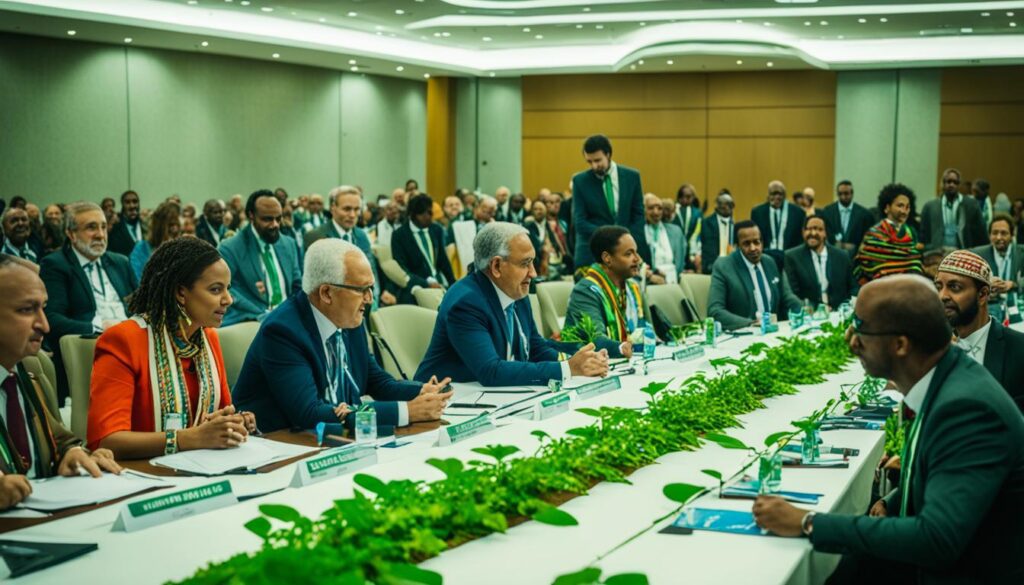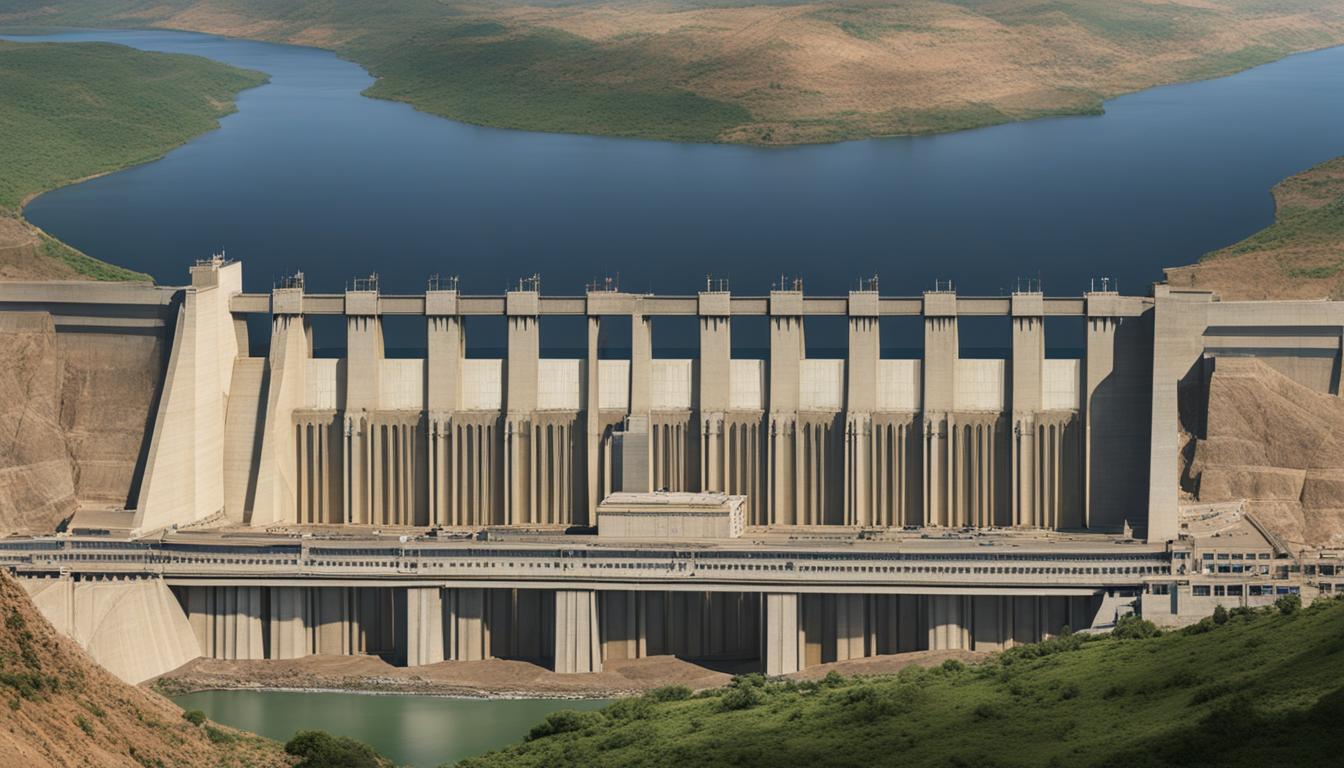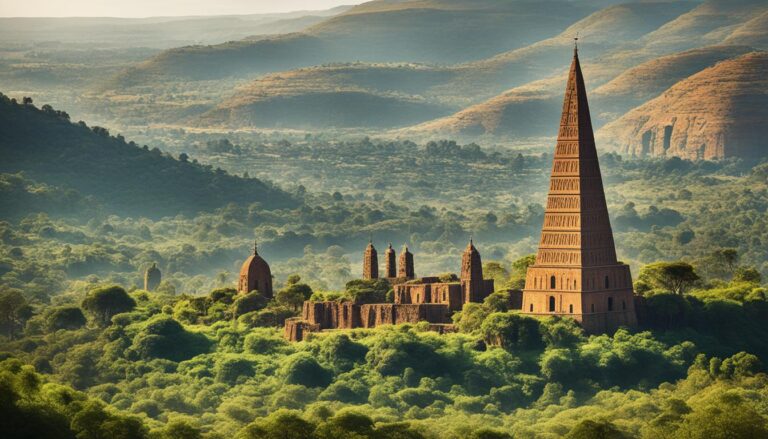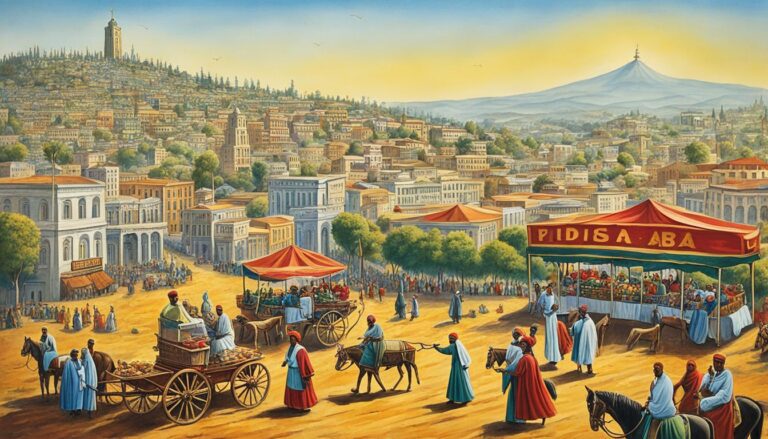Can Ethiopia Defeat Egypt?
Did you know that Ethiopia’s Grand Ethiopian Renaissance Dam (GERD) is set to become the largest hydroelectric power plant in Africa? Its reservoir is projected to hold 74.6 billion cubic meters of water, which is equivalent to almost 30 million Olympic-sized swimming pools.
- Ethiopia and Egypt are locked in a contentious dispute over the Nile River, with Egypt voicing concerns over the impact of the dam on its water supply and threatening military action.
- Examining the historical context, military capabilities, and diplomatic efforts is crucial in understanding the potential outcome of this high-stakes water dispute in the Horn of Africa.
- Despite historical military engagements and Egypt’s superior conventional military strength, Ethiopia’s determination to harness its resources for economic development poses a formidable challenge.
- Diplomatic efforts, mediated by the African Union, hold promise for a peaceful resolution, but reaching a comprehensive agreement that satisfies all parties’ interests remains a challenge.
- The path to peace lies in sustained negotiations, compromise, and international cooperation, with regional stability and the sustainable management of the Nile’s waters at stake.
Background of the Conflict
The conflict between Egypt and Ethiopia surrounding the Nile River is deeply rooted in their historical relationship and differing perspectives on water resources. As a downstream country, Egypt heavily relies on the Nile for its water supply, while Ethiopia, as an upstream country, seeks to harness the river’s potential for development through projects like the Grand Ethiopian Renaissance Dam (GERD).
The dispute over the Nile’s waters and the construction of infrastructure projects has led to tensions between the two nations. Egypt has historically attempted to maintain control over the region, while Ethiopia asserts its right to utilize the river for its own socio-economic growth. These conflicting interests, along with the absence of a comprehensive agreement among riparian states, have further fueled the Nile River dispute.
Historical Attempts at Control
“Egypt has long regarded itself as the historic custodian of the Nile and has sought to maintain control over its waters.”
Throughout history, Egypt has perceived itself as the rightful guardian of the Nile, defending its interests and asserting dominance over the region. This sense of entitlement has often clashed with Ethiopia’s aspirations for development and sovereignty in utilizing the river for its own benefit.
The absence of a comprehensive agreement on the sharing of Nile waters has contributed to the ongoing disputes and negotiations among riparian states. Efforts to find a fair and equitable distribution of Nile resources have yet to reach a satisfactory resolution, leaving room for continued tensions and disagreements.
| Egypt | Ethiopia |
|---|---|
| Downstream country | Upstream country |
| Reliant on Nile waters | Seeking to harness river’s potential |
| Asserts historical control | Asserts national sovereignty |
| Concerns over water resources | Focus on economic development |
“The differing perspectives on the utilization of the Nile’s waters and the impact of infrastructure projects on downstream countries have intensified the conflict.”
Historical Military Engagement

In the past, Egypt and Ethiopia have been involved in military conflicts, one of which was the Egyptian-Ethiopian War that took place from 1874 to 1876. This war proved to be a significant moment in Ethiopian history as it resulted in their victory and the preservation of their independence. During the conflict, two key battles emerged as turning points: the Battle of Gundet and the Battle of Gura. Ethiopian forces successfully repelled the Egyptian invaders, solidifying their position in the region.
It is important to consider these historical military engagements as they provide insights into the dynamics between Egypt and Ethiopia. However, it is essential to acknowledge that the modern geopolitical landscape and military capabilities have evolved significantly since then.
“The Ethiopian victory in the Egyptian-Ethiopian War of 1874-1876 marked a crucial milestone in our nation’s history. It showcased our resilience and determination to safeguard our independence and sovereignty.” – Emperor Yohannes IV
The Battle of Gundet
The Battle of Gundet was a pivotal confrontation that occurred in the early stages of the Egyptian-Ethiopian War. Ethiopian forces, led by Emperor Yohannes IV, successfully withstood the Egyptian assault and emerged victorious. This triumph boosted the morale and confidence of Ethiopian troops, demonstrating their ability to defend their homeland against external threats.
The Battle of Gura
In the Battle of Gura, Ethiopian forces once again repelled the Egyptian invaders, solidifying their hold on the region. This victory further cemented Emperor Yohannes IV’s leadership and Ethiopia’s determination to maintain its independence despite Egypt’s historical dominance over the Nile River.
While the historical military engagements between Egypt and Ethiopia offer valuable insights into their past dynamics, it is imperative to approach the current situation with an understanding of the evolved geopolitical landscape and the modern military capabilities of both nations.
“Ethiopia’s triumph in battles such as Gundet and Gura serves as a reminder of our resilience and ability to defend our sovereignty in the face of external threats.” – Emperor Yohannes IV
Military Capabilities

When assessing the military capabilities of Egypt and Ethiopia, it is crucial to consider each country’s armed forces. Egypt’s military, known as the Egyptian Armed Forces (EAF), is widely regarded as one of the strongest in the region.
The Egyptian Armed Forces have a large standing army, advanced weaponry, and air superiority, providing them with a significant advantage over Ethiopia in terms of conventional military strength. Their well-equipped land forces and powerful air forces contribute to an impressive military prowess.
However, it would be a mistake to underestimate the Ethiopian National Defense Force (ENDF). While Ethiopia may not match Egypt’s firepower and technological advancements, they have focused on building a capable defense force that can leverage their home-field advantage in any potential conflict.
Although Ethiopia’s land forces and air forces may not possess the same level of sophistication as their Egyptian counterparts, their military strength should not be dismissed. Ethiopia has demonstrated a commitment to developing their military capabilities and can mobilize their forces effectively in their own territory.
“Despite the disparity in military strength, Ethiopia has strategically positioned its defense forces to effectively defend its interests.”
While numerical and technological advantages favor Egypt, Ethiopia’s determination to protect its national sovereignty cannot be understated. In any potential conflict, Ethiopia’s knowledge of its own terrain and the resilience of its forces could present challenges for the Egyptian Armed Forces.
Land Forces
Egyptian Armed Forces: Egypt maintains a well-trained and formidable land force, equipped with advanced weaponry and armor. With a significant number of active personnel, armored vehicles, and artillery units, the Egyptian land forces possess the capacity to conduct offensive and defensive operations effectively.
Ethiopian National Defense Force: Ethiopia has invested in building a sizable land force capable of defending its borders and maintaining internal security. Their forces consist of well-trained ground troops, armored vehicles, and artillery units that can provide a strong defense, particularly when operating on Ethiopian soil.
Air Forces
Egyptian Armed Forces: Egypt’s Air Force is one of the most advanced and powerful in Africa, boasting a wide range of fighter jets, attack helicopters, and strategic bombers. With its modern aerial capabilities, Egypt can effectively project air power and maintain air superiority in potential conflicts.
Ethiopian National Defense Force: Ethiopia’s Air Force may not match Egypt’s in terms of equipment and technology, but it maintains a functional fleet of fighter jets, transport aircraft, and helicopters. Their air capabilities allow them to conduct air support, transport, and reconnaissance missions in defense of their interests.
Diplomatic Efforts

Recognizing the potential risks and consequences of a military escalation, diplomatic efforts have been underway to find a peaceful resolution to the Nile River dispute. The African Union (AU) has been mediating between Egypt, Ethiopia, and Sudan to facilitate negotiations and foster dialogue. International cooperation and involvement from key stakeholders, including the United States and the European Union, have been critical in supporting these diplomatic efforts. While progress has been made, reaching a comprehensive agreement that satisfies all parties’ interests remains a challenge.
Regional Geopolitics
The Nile River dispute between Egypt and Ethiopia is not isolated from the broader regional geopolitics of East Africa. The Horn of Africa region is characterized by complex power dynamics and the influence of external actors, which can significantly impact the outcome of the conflict.
One of the key regional players is Sudan, a country that also relies on the Nile waters and holds a vested interest in finding a resolution that balances its needs with those of Egypt and Ethiopia. Sudan’s participation and perspective in the negotiations can greatly shape the dynamics of the dispute and influence potential outcomes.
Furthermore, regional organizations like the Intergovernmental Authority on Development (IGAD) play a significant role in facilitating dialogue and cooperation among the riparian countries. Through mediation and diplomatic efforts, IGAD aims to address the complexities of the conflict and promote regional stability.
“The involvement of external actors cannot be overlooked in understanding the regional dynamics of the Nile River dispute.” – African Affairs Expert
Economic and Environmental Implications
The Nile River is a vital resource for both Egypt and Ethiopia, playing a crucial role in supporting key sectors such as agriculture and energy production. The construction and operation of the Grand Ethiopian Renaissance Dam (GERD) have significant implications for the economies of both countries and the overall environmental sustainability of the Nile Basin.
Proper management of water resources is essential to avoid long-term conflicts and ensure the prosperity of all riparian countries. Equitable sharing and sustainable development practices will be key in maximizing the benefits while minimizing the potential negative impacts on water availability, environmental ecosystems, and the livelihoods of local communities.
Economic Implications
The Nile River represents a lifeline for Egypt’s agricultural sector, providing irrigation for crops that feed millions of people. The dam’s impact on downstream water flow and sedimentation patterns could potentially disrupt agricultural productivity and negatively affect Egypt’s food security. It is essential for both countries to find a balance that ensures the sustenance of Egypt’s agricultural sector while allowing Ethiopia to generate electricity and achieve its development goals.
For Ethiopia, the GERD represents a significant investment in energy infrastructure and a source of potential revenue through electricity exports. The reliable and affordable energy generated by the dam can be a catalyst for economic growth, enabling Ethiopia to meet the energy demands of its population and drive industrialization. However, careful consideration must be given to the potential displacement of local communities and the associated socio-economic impacts.
Environmental Implications
The Nile Basin is home to diverse ecosystems and unique wildlife. The construction and operation of the GERD may alter water flow patterns, disrupt riverine habitats, and impact the migration patterns of aquatic species. It is vital for both countries to implement sustainable practices that minimize environmental degradation and support the conservation of nature within the Nile Basin.
Furthermore, the dam’s reservoir can have unforeseen consequences on water quality and the accumulation of sediment, which can affect downstream ecosystems. Ongoing monitoring and research are necessary to understand and mitigate any potential adverse environmental impacts.
| Economic Implications | Environmental Implications |
|---|---|
| – Impact on agriculture and food security in Egypt | – Altered water flow patterns |
| – Energy generation and potential revenue for Ethiopia | – Disruption of riverine habitats |
| – Socio-economic impacts on local communities | – Impact on aquatic species migration |
| – Balancing development goals and environmental sustainability | – Water quality and sediment accumulation |
The economic and environmental implications associated with the GERD require thoughtful and collaborative approaches from both countries. By prioritizing sustainable water resource management, equitable sharing of benefits, and environmental conservation, Egypt and Ethiopia can ensure the long-term prosperity and stability of the Nile Basin for future generations.
The Path to Peace
Finding a peaceful resolution to the Nile River dispute requires a commitment to dialogue, compromise, and international cooperation. It is essential for Egypt and Ethiopia to engage in meaningful negotiations that address the concerns of both parties and consider the interests of all riparian states. A negotiated settlement that takes into account historical rights, sovereignty, and equitable sharing of Nile waters is crucial for long-term stability in the region. Continued international support, particularly from the African Union (AU) and other key stakeholders, can facilitate the path to peace.
With the potential risks and consequences of military escalation evident, diplomacy is the key to resolving the conflict peacefully. By sitting at the negotiation table, both Egypt and Ethiopia can work towards a compromise that respects their respective needs and aspirations. This negotiated settlement should not only address the current issues surrounding the dispute but also consider the historical context and sovereignty of the involved nations.
Achieving a negotiated settlement requires international cooperation. The support of organizations like the African Union, as well as the involvement of international stakeholders, can help facilitate constructive dialogue and foster a conducive environment for resolution. By working together, nations can contribute to a comprehensive agreement that ensures the long-term stability and sustainable management of the Nile’s waters.
“The path to peace lies in dialogue, compromise, and international cooperation. Only through a negotiated settlement can Egypt and Ethiopia find a resolution that respects their interests and promotes regional stability.” – African Union Diplomat
Conclusion
The ongoing Nile River dispute between Ethiopia and Egypt is a complex and multifaceted issue with far-reaching implications. Historically, Egypt has held dominant influence over the river, but Ethiopia’s determination to utilize its resources for economic development has posed a significant challenge. The key to resolving this conflict lies in diplomatic efforts, international cooperation, and a commitment to finding a negotiated settlement that addresses the concerns and interests of all parties involved.
By prioritizing dialogue and compromise, both Ethiopia and Egypt can work towards a diplomatic resolution that ensures regional stability and the sustainable management of the Nile’s waters. It is crucial for all riparian states to engage in meaningful negotiations, considering historical rights, sovereignty, and equitable sharing of Nile waters. International support, particularly from organizations like the African Union, plays a vital role in facilitating this process.
Achieving a peaceful resolution to the Nile River dispute is not only in the best interest of Ethiopia and Egypt but also of paramount importance for the overall stability of the region. With careful diplomacy and a commitment to finding common ground, it is possible to strike a balance that allows for the development and prosperity of all parties involved while safeguarding the long-term sustainability of the Nile River ecosystem.





